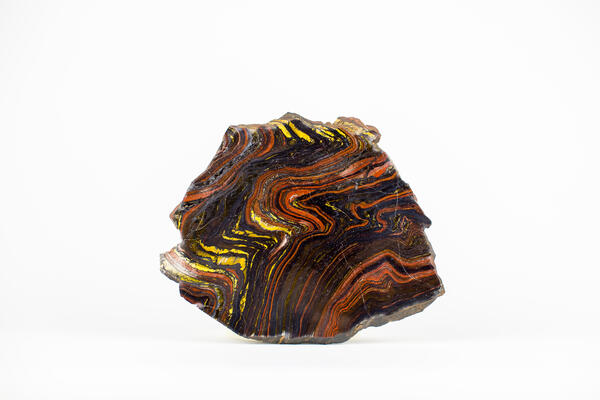Jaspilite is a laminated ferruginous quartz rock of sedimentary or volcanic origin. It is also referred to as taconite, itabirite, ferruginous quartzite, or ferruginous hornstone. Its world’s largest deposits are located in the area of the Kursk Magnetic Anomaly in Russia, near the Ukrainian city of Kryvyi Rih and Minas Gerais in Brazil.
Large jaspilite deposits originated on the Earth in the Proterozoic era about 2 billion years ago. The seawater contained dissolved iron, which was formed as a result of volcanic activity. Closer to the surface of the ocean, it reacted with oxygen molecules, oxidized, and precipitated out as insoluble sludge, which became the main component of jaspilite.
Jaspilite resembles a gemstone jasper. That is where its name comes from. Thin, no more than two millimeters, multi-colored stripes are formed by layers of quartz, hematite, and magnetite. The layers can be red, black, white, blue, or gray, depending on the exact composition. Sometimes there are aventurine or pyrite inclusions. Jewelers especially appreciate such stones.
The mineral structure is heterogeneous, and its layers can crumble when processed. Therefore, jaspilite is not suitable for carving and creating complex figures. Most often pyramids or spheres of different diameters are carved out of them, which serve as table decorations. There are also jewelry boxes made of this mineral, beads, and flat inserts-cabochons for men’s and women’s jewelry. Most often, the setting for jaspilite jewelry is made of silvery cupronickel. Fake jaspilites made of inexpensive plastic occasionally appear on sale. They can be distinguished by the fact that they heat up in the hands faster than natural stone, the stripes of such products are too smooth and clear, and the pattern is often repeated.
Jaspilite not suitable for jewelry is used in construction. It is added to concrete to increase its strength, and used in the form of crushed stone in road construction, also floor coverings are made from it. In addition, in metallurgical industry, it is necessary for the production of refractory materials.
Large jaspilite deposits originated on the Earth in the Proterozoic era about 2 billion years ago. The seawater contained dissolved iron, which was formed as a result of volcanic activity. Closer to the surface of the ocean, it reacted with oxygen molecules, oxidized, and precipitated out as insoluble sludge, which became the main component of jaspilite.
Jaspilite resembles a gemstone jasper. That is where its name comes from. Thin, no more than two millimeters, multi-colored stripes are formed by layers of quartz, hematite, and magnetite. The layers can be red, black, white, blue, or gray, depending on the exact composition. Sometimes there are aventurine or pyrite inclusions. Jewelers especially appreciate such stones.
The mineral structure is heterogeneous, and its layers can crumble when processed. Therefore, jaspilite is not suitable for carving and creating complex figures. Most often pyramids or spheres of different diameters are carved out of them, which serve as table decorations. There are also jewelry boxes made of this mineral, beads, and flat inserts-cabochons for men’s and women’s jewelry. Most often, the setting for jaspilite jewelry is made of silvery cupronickel. Fake jaspilites made of inexpensive plastic occasionally appear on sale. They can be distinguished by the fact that they heat up in the hands faster than natural stone, the stripes of such products are too smooth and clear, and the pattern is often repeated.
Jaspilite not suitable for jewelry is used in construction. It is added to concrete to increase its strength, and used in the form of crushed stone in road construction, also floor coverings are made from it. In addition, in metallurgical industry, it is necessary for the production of refractory materials.



